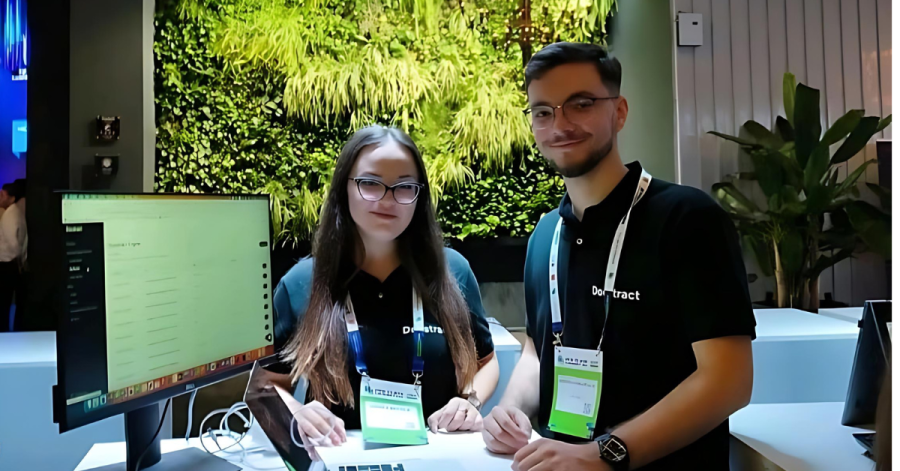Not all mistakes are bad. Sometimes these can help you make some decisions you’d never think about.
In this article, I will share my story of starting and selling Docstract, a tool for data extraction from unstructured documents such as receipts, invoices, and so on, through LLM technology, in 3 months.
Docstract’s Birth
In 2022, I invested in Jobful and started a partnership through my web development agency. Through this, in 2023, we received a request for a plugin solution in Jobful from a Romanian Enterprise Client — a Python microservice, which, by connecting it to Jobful, extracts data from onboarding documents (Identity Card, Birth Certificate, Education Diploma, etc.)
After successfully delivering this project with a colleague from the university, Bianca Necula, I realized that based on this work, we could build a product for unstructured documents targeting small and medium businesses.
We worked on an MVP that had good accuracy. We used a mix of tools like:
- Laravel & Inertia JS for the Web App;
- Python & OpenAI for the AI part micro-service;
- Google Cloud for the Python microservice;
- AWS S3 bucket for the file storage;
- OVH for the VPS hosting;
- Gitbook for the API documentation;
- Tawk.to for the website chat;
- Mailchimp for the newsletter;
- Cloudflare;
- Stripe for the payments;
- Github for the repo;
- Hubspot for the sales CRM part;
- Apollo for the outreach system;
The mistake
After trying to onboard some clients, we realized that we cut some corners: we were building a product without validating it in the market.
Only once we had the MVP ready, we started discussing with different clients from the mid-market and realized that the pain was not too hard for this market because they wouldn’t process a lot of documents. We tried to focus on different niches, but the result was the same — the pain point was felt only by bigger companies, and bigger companies need a lot of input and output integrations.
The decision
When realizing that we needed to make a shift to have success, and considering that we are bootstrapped and my co-founder was less than a part-time, we had two options: sell the project or make it primary in our lives, get investment, and build a robust platform with a lot of input and output integrations.
Through internal meetings, we decided to sell the project through a marketplace called Acquire.
The selling process
The listing
We created an account on the platform and listed Docstract. Once our post was approved, in less than two days, we had 30+ NDAs signed by potential buyers. From these NDAs, we had two serious potential customers, and after some discussions, we decided to move further with a US company specializing in automation software for accounting.
The LOI (Letter Of Intent) & APA (Asset Purchase Agreement)
A potential buyer can send you an LOI (Letter OF Intent) with the offer. After accepting the offer from the buyer, your listing becomes “under offer”, and nobody can sign NDAs anymore.
When you sign the LOI, you move to the next step, where an APA is created. The APA is a document where you, as a seller, write all the assets you’ll provide, and the buyer signs to pay for these assets.
The due diligence process
Before signing the APA, we started a due diligence process with the buyer. Because the business wasn’t too big, this due diligence process consisted of a few online meetings and discussions about the tech architecture, market, third parties used, and how we could finish the migration.
When the APA is signed, both parties need to create an account on escrow.com.
Escrow is a platform integrated into Acquire that allows the buyer to deposit money and notify the seller to start the migration process.
By pressing one button from the Acquire’s interface, the APA is automatically sent to Escrow, where the buyer deposits the money. At that point, I started the migration process.
If you want to sell your startup, consider this
I was inspired when I started this startup and created everything for this project separately. I started with a Gmail account, and from this account, I created the rest of the accounts separately (VPS, Tawk.to, etc). That helped me a lot because the migration process was straightforward. I just changed the Gmail account password and the business details of the third parties, and the buyer had access to the entire startup.
Also, don’t use legacy versions of the tech stack—for example, if you’re using Laravel 5 in your project and the current version of Laravel 11, the buyer will not be happy.
Once the migration was ready (3 hours in a meeting with the buyer), the buyer finalized the escrow.com migration and in ~2 days, the money was in my account.
Gold lessons
After building and selling Docstract, I realized the following:
- There is a huge M&A market for MicroSAAS;
- Is very important to separate all your accounts when you launch a new product;
- Use technologies that allow you to build fast with a small learning curve;
- Conduct an interview with yourself before starting to build a start-up. Founder market fit is one of the most important things;
- Validate, validate, validate!
- A start-up, a business, or a product is about YOU! Build a network, learn things, and take care of yourself and your family, and even if you fail with a venture, your gain will be exponential!








